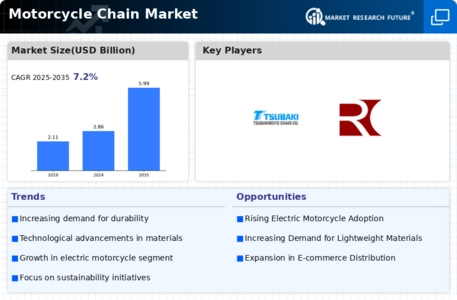Market Analysis
In-depth Analysis of Motorcycle Chain Market Industry Landscape
The motorcycle chain market is influenced by various market factors that play a pivotal role in shaping its dynamics. One of the primary factors driving this market is the global surge in demand for motorcycles. As more individuals seek affordable and fuel-efficient transportation options, motorcycles have gained popularity, particularly in developing economies. This increased demand directly impacts the need for motorcycle chains, as they are a critical component in transmitting power from the engine to the wheels.
Moreover, technological advancements have significantly contributed to the growth of the motorcycle chain market. Innovations in chain materials, such as the adoption of advanced alloys and coatings, enhance the durability and performance of chains. Manufacturers are continually investing in research and development to create chains that can withstand higher torque and stress levels, providing riders with a smoother and more reliable experience.
In addition to technological advancements, environmental considerations are increasingly shaping the motorcycle chain market. The growing awareness of environmental sustainability has led to a rise in the demand for electric motorcycles. While electric motorcycles do not require traditional chains for power transmission, the overall expansion of the motorcycle market, including both conventional and electric models, continues to drive the demand for chains.
Economic factors also exert a significant influence on the motorcycle chain market. Fluctuations in fuel prices and economic conditions impact consumer purchasing power and, subsequently, the sales of motorcycles. During economic downturns, consumers may delay or forego purchasing motorcycles, leading to a temporary decline in the demand for associated components like chains. Conversely, during periods of economic growth, increased disposable income often translates into higher motorcycle sales, boosting the market for chains.
The competitive landscape plays a crucial role in shaping the dynamics of the motorcycle chain market. Manufacturers are constantly engaged in strategic activities such as mergers, acquisitions, and partnerships to strengthen their market position. The presence of well-established players with extensive distribution networks and brand recognition poses challenges for new entrants, while fostering innovation and healthy competition within the market.
Government regulations and standards also contribute to the market factors influencing the motorcycle chain industry. Stringent emission norms and safety standards imposed by regulatory bodies can drive manufacturers to develop and adopt advanced technologies, affecting the overall design and materials used in motorcycle chains. Compliance with these regulations not only ensures the market relevance of manufacturers but also addresses the environmental concerns associated with the motorcycle industry.
Furthermore, consumer preferences and trends impact the motorcycle chain market. Aesthetic considerations, such as the desire for customized or stylish motorcycles, influence the design and appearance of chains. Manufacturers need to stay attuned to these trends to cater to the evolving preferences of motorcycle enthusiasts.
In conclusion, the motorcycle chain market is shaped by a complex interplay of factors ranging from technological advancements and environmental considerations to economic conditions and consumer preferences. As the global demand for motorcycles continues to rise, manufacturers in the motorcycle chain market must remain adaptable and innovative to address the dynamic nature of these influencing factors.









Leave a Comment